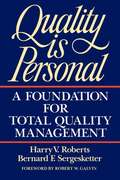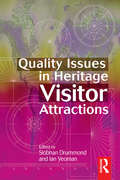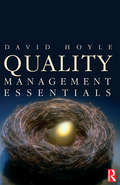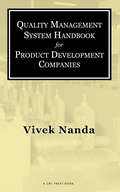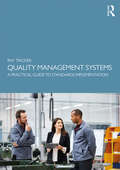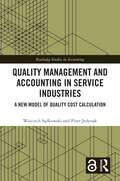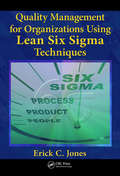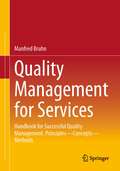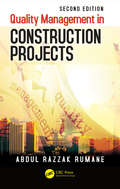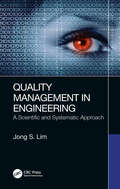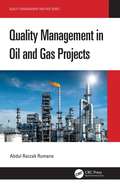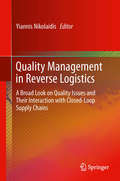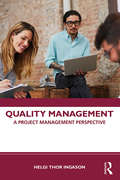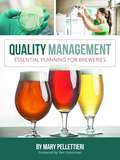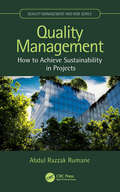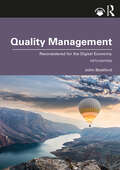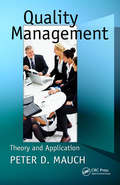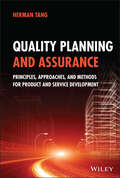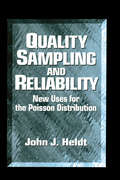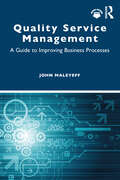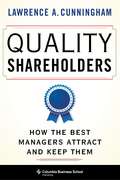- Table View
- List View
Quality Is Personal: A Foundation for Total Quality Management
by Harry V. RobertsIn this penetrating guide to involving employees in the process of total quality management, the authors make the argument that "personal quality checklists"--by which employees monitor waste reducers and value adding activities in their immediate work environment--can significantly increase individual understanding of the general concepts and implementation of top quality management.
Quality Issues in Heritage Visitor Attractions
by Ian Yeoman* Quality as a tool for success*Covers a diverse range of quality issues and theories in the context of heritage attractions* Well-respected international contributor team of academics and practitionersHeritage Tourism is the fastest growing component of the tourism market. Tourists have more choices than ever and their past experiences and future expectations make them even more discerning customers. A focus on quality can assist with customer satisfaction and business excellence. This new book on Quality issues brings together a range of specialists who lead us from the evolution of quality to our current position on the quality roadmap. It provides a toolkit to assist on the continuous quality improvement journey and presents a vision of what lies ahead in this new millennium.'Quality Issues in Heritage Visitor Attractions' will prove an invaluable guide for students and practitioners in the field s of Heritage, Visitor Attractions and Tourism in general.Divided into six sections this text presents a different 'flavour' of quality by looking at aspects such as critical success factors for heritage organizations, methods of quality improvement, developing the concept and offering, quality tools for managers, managing the quality workforce and the future.
Quality Lighting for High Performance Buildings
by Michael StillerThis book provides an overview of the basic concepts of quality, indoor lighting, and explains concepts like visual comfort, visual interest, and integrated design as they relate to the practice of lighting design. Energy-efficient lighting technologies, including LED lighting and digital control systems, and design strategies that increase visual comfort and productivity are discussed in plain language, and examined in a straightforward way to give the reader, whether an architect, interior designer, engineer, building trades professional, or student a broad understanding of the art and science of energy-efficient quality lighting.
Quality Management Essentials
by David HoyleFrom the best-selling quality management author, David Hoyle, Quality Management Essentials is the perfect brief, yet authoritative, introduction to the fundamentals of quality management. Quality in organizations, large or small, is achieved with intelligent use of various concepts, principles, tools and techniques. For those coming to the subject for the first time, these philosophies associated with quality management can be quite overwhelming. This very readable book provides a fast track introduction and executive level appraisal of the field from a respected and experienced author.
Quality Management System Handbook for Product Development Companies
by Vivek NandaQuality Management System Handbook for Product Development Companies describes a systematic approach for quality management and continuous improvement via a formal management system.� The approach centers on a high-level process for defining a QMS � from essential prerequisites to improvement mechanisms. The book outlines the five major QMS
Quality Management Systems: A Practical Guide to Standards Implementation
by Ray TrickerThis book provides a clear, easy to digest overview of Quality Management Systems (QMS). Critically, it offers the reader an explanation of the International Standards Organization’s (ISO) requirement that in future all new and existing Management Systems Standards will need to have the same high-level structure, commonly referred to as Annex SL, with identical core text, as well as common terms and definitions. In addition to explaining what Annex SL entails, this book provides the reader with a guide to the principles, requirements and interoperability of Quality Management System standards, how to complete internal and external management reviews, third-party audits and evaluations, as well as how to become an ISO Certified Organisation once your QMS is fully established. As a simple and straightforward explanation of QMS Standards and their current requirements, this is a perfect guide for practitioners who need a comprehensive overview to put theory into practice, as well as for undergraduate and postgraduate students studying quality management as part of broader Operations and Management courses.
Quality Management and Accounting in Service Industries: A New Model of Quality Cost Calculation (Routledge Studies in Accounting)
by Piotr Jedynak Wojciech SadkowskiThe process of globalisation in world markets, and the growing number of enterprises competing with one another in terms of the products and services they offer, naturally leads to the improved efficiency of management systems. Efficiency is required in order for these entities to maintain competitiveness. To assess the efficiency of their management systems, enterprises use quality cost calculation. This book fills the research gap concerned with the scientific study of the quality cost calculation, with regard to service companies. It offers the authors' concept of using the cost of quality calculation as a tool for assessing the efficiency of the management systems of service companies. The book consists of six chapters that present both a theoretical and an empirical part. In the theoretical part, the following issues are discussed: quality costs; the evolution of quality cost calculation; quality cost calculation models and their applications to date; and the specific way in which service companies operate. The practical part presents the authors' model of quality cost calculation along with the adopted assumptions and cost structure, as well as the research methodology and verification of the use of the developed model in a selected service company. The research gives credence to the role and importance of this tool in economic practice. The book will be desired reading by both theoreticians and practitioners of quality management and accounting. It is also a valuable resource for master’s and doctoral students wishing to broaden their knowledge of quality costs and their calculation in the fields of economics and management.
Quality Management for Organizations Using Lean Six Sigma Techniques
by Erick JonesThe next step in the evolution of the organizational quality field, Lean Six Sigma (LSS) has come of age. However, many challenges to using LSS in lieu of, in conjunction with, or integrated with other quality initiatives remain. An update on the current focus of quality management, Quality Management for Organizations Using Lean Six Sigma Techniqu
Quality Management for Services: Handbook for Successful Quality Management. Principles – Concepts – Methods
by Manfred BruhnThis book provides assistance for ensuring and increasing service quality. Manfred Bruhn presents a holistic, scientifically based approach to quality management for services, which is consistently oriented to the management process with the phases of analysis, planning, control and monitoring of quality management. Core parts of the book are procedures for measuring service quality, instruments for controlling quality and expectation management, the implementation of quality management based on ISO 9000 ff. standards as well as the EFQM model, and comprehensive quality controlling to ensure effectiveness and efficiency.In the eleven editions to date, the work has evolved into a handbook and can be used as a reference work for the various topics of quality management for services. Individual topics of quality management or the respective chapters can be worked through independently of each other.In the 12th edition, all chapters have been updated. In particular, the new version of the EFQM Model 2020 has been comprehensively presented.The contentsBasics of quality management for servicesAnalysis of service qualityPlanning and control of quality management for servicesImplementation of quality management for servicesQuality controlling for services
Quality Management in Construction Projects (Systems Innovation Book Series)
by Abdul Razzak RumaneThe first edition published in 2010. The response was encouraging and many people appreciated a book that was dedicated to quality management in construction projects. <P><P>Since it published, ISO 9000: 2008 has been revised and ISO 9000: 2015 has published. The new edition will focus on risk-based thinking which must be considered from the beginning and throughout the project life cycle. <P><P>There are quality-related topics such as Customer Relationship, Supplier Management, Risk Management, Quality Audits, Tools for Construction Projects, and Quality Management that were not covered in the first edition. Furthermore, some figures and tables needed to be updated to make the book more comprehensive.
Quality Management in Engineering: A Scientific and Systematic Approach
by Jong S. LimThis book introduces fundamental, advanced, and future-oriented scientific quality management methods for the engineering and manufacturing industries. It presents new knowledge and experiences in the manufacturing industry with real world case studies. It introduces Quality 4.0 with Industry 4.0, including quality engineering tools for software quality and offers lean quality management methods for lean manufacturing. It also bridges the gap between quality management and quality engineering, and offers a scientific methodology for problem solving and prevention. The methods, techniques, templates, and processes introduced in this book can be utilized in various areas in industry, from product engineering to manufacturing and shop floor management. This book will be of interest to manufacturing industry leaders and managers, who do not require in-depth engineering knowledge. It will also be helpful to engineers in design and suppliers in management and manufacturing, all who have daily concerns with project and quality management. Students in business and engineering programs may also find this book useful as they prepare for careers in the engineering and manufacturing industries. Presents new knowledge and experiences in the manufacturing industry with real world case studies Introduces quality engineering methods for software development Introduces Quality 4.0 with Industry 4.0 Offers lean quality management methods for lean manufacturing Bridges the gap between quality management methods and quality engineering Provides scientific methodology for product planning, problem solving and prevention management Includes forms, templates, and tools that can be used conveniently in the field
Quality Management in Oil and Gas Projects (Quality Management and Risk Series)
by Abdul Razzak RumaneThis book provides the tools and techniques, management principles, procedures, concepts, and methods to ensure the successful completion of an oil and gas project while also ensuring the proper design, procurement, and construction for making the project most qualitative, competitive, and economical for safer operational optimized performance. It discusses quality during design, FEED, detailed engineering, selection of project teams, procurement procedure of EPC contract, managing quality during mobilization, procurement, execution, planning, scheduling, monitoring, control, quality, and testing to achieve the desired results for an oil and gas project. This book provides all the related information to professional practitioners, designers, consultants, contractors, quality managers, project managers, construction managers, and academics/instructors involved in oil and gas projects and related industries. Features Provides information on the various quality tools used to manage construction projects from inception to handover Discusses the life cycle phases, developed on systems engineering approach, and how it is divided into manageable activity/element/components segments to manage and control the project Includes a wide range of tools, techniques, principles, and procedures used to address quality management Covers quality management systems and development of quality management systems manuals Discusses quality and risk management, and health, safety, and environmental management during the design and construction process
Quality Management in Reverse Logistics
by Yiannis NikolaidisQuality Management in Reverse Logistics intends to develop, collect, examine and evaluate a number of quality management (QM) tools and techniques, which can be applied in practice in order to understand, review and improve any closed-loop supply chain process. In other words, the book aims to examine the existing relationship between various well-developed and thoroughly studied quality issues, such as QM, quality assurance, standardization of processes and statistical quality control and the emerging research area of reverse logistics. Quality Management in Reverse Logistics contains modeling and quantitative methods that could be used by practitioners and academics in the reverse logistics industry, as well as a thorough description of QM tools and techniques. The book leads the potential reader to broaden their scope of thinking and acting in the new, promising area of reverse logistics, where QM can be applied.
Quality Management, Value Creation, and the Digital Economy (Routledge Advances in Production and Operations Management)
by Muhammad Shahbaz Justyna Żywiołek Joanna Rosak-SzyrockaIn the conditions of the modern market economy, in which globalization and competition are rife, quality is of great importance for determining a company's position in the market. The changing and complex economic reality is shaping new market patterns while modern technologies influence purchasing decisions. This book presents an effective and novel framework for creating value in Industry 4.0 conditions by building a smart enterprise model using quality management theories. The book explores tools and platforms that can be utilized to contribute to the creation of the ideal quality for demanding customers, using case studies from international contributors. It proposes novel architectures that drive economically viable production and services businesses, addressing unique Industry 4.0 and 5.0 solutions in Internet of Things (IoT) that involve the entire spectrum of analysis, with a special focus on lean methodologies and cybersecurity. This original book will be valuable reading for researchers and scholars in the areas of quality management, manufacturing, production, and operations management.
Quality Management: A Project Management Perspective
by Helgi Thor IngasonThe implementation of quality management can be seen as a sequence of projects and evolves as a result of how projects are planned, executed and closed. This book explores quality management from a project management perspective, based on the author’s long experience of teaching and practicing, including the implementation and operation of quality management systems within various types of organisations. The author explores the origins of quality management as a discipline, it’s appearance in the present form and how quality management can be implemented and applied in all kinds of organisations to achieve stability and better results. The basic principles of quality management and the ISO9001 quality management standard are discussed and explained from a broad perspective, with illustrative examples from different types of organisations. Quality Management offers a global, accessible guide for undergraduate and postgraduate university students. Written clearly and with illustrative examples, it will also appeal to all those interested in project management and quality management and wishing to expand their knowledge base.
Quality Management: Essential Planning for Breweries
by Mary PellettieriQuality management for small, regional, and national breweries is critical for the success of craft brewing businesses. Written for staff who manage quality assurance (QA) and quality control (QC) in breweries of all sizes, this book clearly sets out how quality management is integrated into every level of operation.Author Mary Pellettieri shows how quality management is a concept that encompasses not only the &“free from defect&” ethos but combines the wants of the consumer and the art of brewing good beer. Breweries must foster a culture of quality, where governance and management seamlessly merge policy, strategy, specifications, goals, and implementation to execute a QA/QC program. What tests are necessary, knowing that food safety alone does not signify a quality product, adhering to good management practice (GMP), proper care and maintenance of assets, standard operating procedures, training and investment in staff, and more must be considered together if a quality culture is to translate into success.The people working at a brewery are the heart of any quality program. Management must communicate clearly the need for quality management, delineate roles and responsibilities, and properly train and assess staff members. Specialist resources such as a brewery laboratory are necessary if an owner wants to be serious about developing standard methods of analysis to maintain true-to-brand specifications and ensure problems are identified before product quality suffers. Staff must know the importance of taking corrective action and have the confidence to make the decision and implement it in a timely fashion. With so many processes and moving parts, a structured problem-solving program is a key part of any brewery's quality program.How should you structure your brewing lab so it can grow with your business? What chemical and microbiological tests are appropriate and effective? How are new brands incorporated into production? How do you build a sensory panel that stays alert to potential drifts in brand quality? Which FDA and TTB regulations affect your brewery in terms of traceability and GMP? Can you conduct and pass an audit of your processes and products? Mary Pellettieri provides answers to these key organizational, logistical, and regulatory considerations.
Quality Management: How to Achieve Sustainability in Projects (Quality Management and Risk Series)
by Abdul Razzak RumaneDivided into four main chapters, this book covers the inception on through to the handover of a project and details the three main stages (study stage, design stage, and construction stage) involved with managing any type of project. The book discusses the sustainability framework and provides an overview of quality management with construction projects along with the most common quality tools used to manage quality and achieve sustainability in projects. Quality Management: How to Achieve Sustainability in Projects takes the reader from start to finish with a focus on the sustainability elements needed to manage quality in projects and details the application of sustainability principles at different stages. The book discusses the quality tools used in managing sustainability and provides concise and complete information on how to easily achieve it through to the project handover stage. The book is written for Project Management professionals such as Project Managers, Quality Managers, Industrial Engineers, and Construction Managers, as well as Design Management professionals, academics, trainers, and graduate students.
Quality Management: Reconsidered for the Digital Economy
by John BeckfordQuality Management: Reconsidered for the Digital Economy continues to provide a one-stop-shop for anyone studying the theory and practice of quality management. Exploring the essentials of management theory and the work of the ‘quality gurus’ who have formed the foundation of current practice, this new edition builds upon the previous editions’ unique critical perspective of quality. Key management practices are considered and extended, including lean thinking, systems methodologies, business process reengineering, organisational learning and intelligent organisations and service quality management. This edition plays particularly close attention throughout to the impact of the 4th Industrial Revolution on quality management, revisiting the meaning of ‘quality’ in an automated and data-driven world. Throughout, case studies have been rewritten including new examples from emerging economies, and practical tools incorporated to enhance learning and application. Replete with examples, vignettes and diagrams, this comprehensive textbook is ideal for those new to the field of quality management and for students on advanced undergraduate and postgraduate courses in Operations Management. Online resources include chapter-by-chapter PowerPoint slides and a test bank of questions.
Quality Management: Theory and Application
by Peter D. MauchIn the past, when goods and services were simpler, measurement of quality was self-evident. As business became more complicated, so too did the implementation of quality management and our ability to measure it. Ultimately, the practice of quality strayed from being a business practice to become much more of an engineering discipline producing plen
Quality Planning and Assurance: Principles, Approaches, and Methods for Product and Service Development
by Herman TangQUALITY PLANNING AND ASSURANCE Discover the most crucial aspects of quality systems planning critical to manufacturing and service success In Quality Planning and Assurance: Principles, Approaches, and Methods for Product and Service Development, accomplished engineer Dr. Herman Tang delivers an incisive presentation of the principles of quality systems planning. The book begins with an introduction to the meaning of the word “quality” before moving on to review the principles of quality strategy and policy management. The author then offers a detailed discussion of customer needs and the corresponding quality planning tasks in design phases, as well as a treatment of the design processes necessary to ensure product or service quality. Readers will enjoy explorations of advanced topics related to proactive approaches to quality management, like failure modes and effects analysis (FMEA). They???ll discover discussions of issues like supplier quality management and the key processes associated with quality planning and execution. The book also includes: A thorough introduction to quality planning, including definitions, discussions of quality system, and an overview of the planning process A comprehensive exploration of strategic planning development, including strategic management, risk management and analysis, and pull and push strategies Practical discussions of customer-centric planning, including customer-oriented design, quality function deployment, and affective engineering In-depth examinations of quality assurance by design, including the design review process, design verification and validation, and concurrent engineering Perfect for senior undergraduate and graduate students in technology and management programs, Quality Planning and Assurance will also earn a place in the libraries of managers and technical specialists in a wide range of fields, including quality management.
Quality Sampling and Reliability: New Uses for the Poisson Distribution
by John J HeldtAs a mathematical model for determining the probable number of outcomes, the new Poisson Distribution tables have long been an easier tool to use for reliability analyses. Longtime quality professional, inventor, and consultant John J. Heldt now makes the Poisson Table even more useful-creating two new tables (available only in this book) with the Poisson terms rearranged for further ease of estimation.Quality Sampling and Reliability: New Uses for the Poisson Distribution simplifies the steps involved with reliability testing; Mean Time Between Failure (MTBF) assessment; advantages and risks involved in reliability life testing; and an example of methodology for tracking the MTBF for products in the field.In addition to the tried-and-true Standard Poisson table, used to review conventional Poisson uses, Heldt's two variations yield these results: Estimations of product Mean Time Between Failures (MTBFs), based on life tests-including the 90%, 80% or 60% envelop for any MTBFs that have been derivedDevelopment of the Operating Characteristic Curves for Life testing-showing the risks and advantages of any test used to assure the product MTBF is not varying in a detrimental mannerWritten for easy comprehension, with numerous illustrations, Quality Sampling and Reliability: New Uses for the Poisson Distribution will help quality professionals, engineers, instructors and students alike in their reliability testing tasks.
Quality Service Management: A Guide to Improving Business Processes
by John MaleyeffProviding clear guidance for anyone servicing internal or external customers, this book offers a framework for analyzing and managing quality using a comprehensive closed-loop approach. This book cuts through the complexities of the mantra ‘better, cheaper, faster’ (BCF) and offers procedures for the evaluation of customer needs, the determination of performance metrics, and the design of effective customer satisfaction surveys. It details basic statistical techniques and packages the framework, procedures, and methods into a management construct that includes external quality certification systems and internal performance management systems. Importantly, the book also describes how these systems can be implemented in a virtual workplace. This quality management book will be essential to service-oriented firms (financial, government, healthcare, hospitality, etc.), as well as any firm with internal customer service processes such as human resource management, purchasing, and accounting. Professionals at all levels, corporate trainers, and students will welcome this book’s common set of principles and tools, accompanied by many case studies that illustrate how they are applied in various environments.
Quality Shareholders: How the Best Managers Attract and Keep Them
by Lawrence CunninghamAnyone can buy stock in a public company, but not all shareholders are equally committed to a company’s long-term success. In an increasingly fragmented financial world, shareholders’ attitudes toward the companies in which they invest vary widely, from time horizon to conviction. Faced with indexers, short-term traders, and activists, it is more important than ever for businesses to ensure that their shareholders are dedicated to their missions. Today’s companies need “quality shareholders,” as Warren Buffett called those who “load up and stick around,” or buy large stakes and hold for long periods.Lawrence A. Cunningham offers an expert guide to the benefits of attracting and keeping quality shareholders. He demonstrates that a high density of dedicated long-term shareholders results in numerous comparative and competitive advantages for companies and their managers, including a longer runway to execute business strategy and a loyal cohort against adversity. Cunningham explores dozens of corporate practices and policies—such as rational capital allocation, long-term performance metrics, and a shareholder orientation—that can help shape the shareholder base and bring in committed owners. Focusing on the benefits for corporations and their investors, he reveals what draws quality shareholders to certain companies and what it means to have them in an investor base. This book is vital reading for investors, executives, and directors seeking to understand and attract the kind of shareholders that their companies need.
Quality Standards for Highly Effective Government: Second Edition
by Richard Mr MalloryA seminal work for the public sector, Quality Standards for Highly Effective Government (Second Edition) redefines what is expected and what is required for excellence in management. The practices presented here also benefit non-profit organizations, and indeed any organization in which services are not directly rewarded by a purchase transaction. The book introduces three new performance standards that frame the value add of management, for processes, systems, and aligned leadership objectives. Along with defining known best practices, these standards create an imperative for the use of Lean and continuous quality improvement as a foundation for good management, built onto that defined structure. These standards also create a means to recognize and reward those managers who build and regularly use this framework. Measurable quality standards are necessary for government, because there is no free market incentivizing government managers for efficiency, and there is no direct penalty for offices that provide poor service. The oversight of government is left to elected officials, who often only get generalized and high level feedback and then only on failure. Where there is failure, the usual response of leadership is to change leadership or to restructure offices. But these actions never get to the level of the workers on the ground, and cannot change whether they have or are currently using best practice modeling. Richard Mallory both defines and shows the logic behind the process management standard, the system management standard, and the aligned leadership objectives standard, and how these apply to front line managers, program and executive managers, and even to elected leaders. Because these standards are measurable and auditable, they can form the basis of an integrated scorecard for every government agency in the world, and a roadmap on how to obtain maximum value from each of them. The credibility of these standards is underwritten and proven through their adoption by the Government Division of the American Society for Quality, and international best practice standards for governments worldwide.
Quality Standards, Value Chains, and International Development
by Johan SwinnenOver the past decades, the world has witnessed an unprecedented growth in global value chains, propelled by increasingly demanding quality standards. These trends lead to concerns about the impact of value chains on development and poverty and about the possible protectionist nature of quality standards in rich countries. This book offers the first integrated theoretical analysis of the economic and political factors which determine the level of quality standards, as well as their economic effects along the value chain. Using realistic assumptions motivated by empirical research, the theoretical framework in this book makes it possible to study the efficiency effects as well as the distributional consequences of one of the most striking evolutions affecting global trade and development today.
